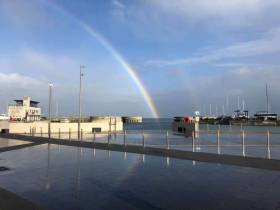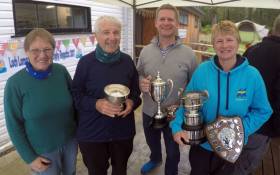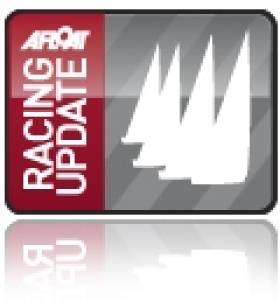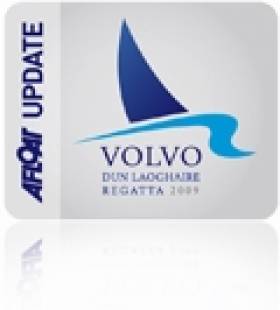Displaying items by tag: Wayfarer
Wayfarer Dinghies Enjoy Cruise from Lough Erne Yacht Club
Once the International Wayfarer rally ended at East Down Yacht Club on Strangford Lough last weekend, five boats with 13 crew headed west to another, albeit smaller but memorable gathering at Lough Erne Yacht Club in County Fermanagh. They were joined by LEYC members James and Tom Burton, who had bought a Wayfarer last year but hadn't been far from the club with it. They really enjoyed sailing in company of other Wayfarers and extending their range significantly both to the south and north.
Lough Erne is actually two connected lakes in the west of Northern Ireland – the biggest lake system in Northern Ireland, which are widened sections of the River Erne, which flows north and then curves west into the Atlantic. The smaller southern lake is called the Upper Lough and the larger lake is called the Lower Lough or Broad Lough. The town of Enniskillen lies on the short stretch of river between the two lakes, which, with 150 islands, along with many coves and inlets, is a major tourist destination.
 Wayfarers on Lough Erne approaching Blaney Bay
Wayfarers on Lough Erne approaching Blaney Bay
The first cruise in the Wayfarers, a dinghy which is very suitable for cruising and racing, was to the famous monastic site on Devenish Island, considered the most important of Lough Erne's many island church settlements. Devenish was founded in the 6th century by St Molaise. It was raided by Vikings in 837 and burned in 1157, but in the Middle Ages flourished as the site of a parish church and St Mary's Augustinian Priory. They went on to the county town of Enniskillen with its 15th-century castle, motoring/sailing/paddling through the lock and to the public jetty for a walk into town and welcome afternoon refreshments at the Buttermarket, a restored 19th-century dairy market.
The next day the group sailed west across the Lough to Carrickreagh Bay, landing at the jetty and walking up to the viewing point. With black clouds approaching the fleet returned to the club and were off the water just in time to escape a torrential downpour. That was followed by a trip by car to Carrybridge, where club member and organiser of the International Rally, John Miller, gave the sailors an outing on Upper Lough Erne in his family cruiser on the beautiful and peaceful waterway down to Knockninney for a short walk to a viewpoint. The return was in thunder and lightning with spectacular cloud formations. The day ended with a visit to Enniskillen Castle and a Riverside walk.
Monica Schaefer from Greystones Sailing Club in Co. Wicklow, recalled sailing past and dropping the mast for the bridges when taking part in a ‘raid’ of the Shannon-Erne waterways. The Wayfarer mast is easily lowered for shooting bridges one of its many qualities as an easily transportable and stable boat for cruising and exploring.
Midweek all six boats set out to the north of LEYC, navigating between the many islands with White Island in Castle Archdale Bay on the east shore of the Lower Lough. It is renowned for its ruined church with built-in carvings dating between 800 and 1000 AD. Three boats turned back and went on in increasingly choppy waters for a challenging, cold and wet ride up to White Island to see the carvings. After sailing across to Castle Archdale, they were met with flasks of hot drinks and cake provided by the ‘returners’. With a brisk following wind, the return to LEYC was swift.
 White Island's carved figures Photo: Geograph
White Island's carved figures Photo: Geograph
The final day of the visit saw light winds and sunshine as the fleet navigated between the many islands up to Tulley Castle near the village of Blaney on the southern shore of Lower Lough Erne. The Blaney area takes its name from Sir Edward Blaney, who was among the English advance party sent to Fermanagh to organise the Plantation in the 17th century.
They passed between Goat Island and Innishmacsaint with its 6th-century church on the approach. The sound of bird song radiating from the islands passed (sometimes in stereo) will be a memory of sailing this wonderful Lough. After a picnic lunch at the Castle, in perfect conditions, the final afternoon of sailing took the group to Blaney Bay, landing to visit a house owned by two if the party for afternoon tea in the garden. Getting three boats up to, then off a tiny landing with numerous hazards to navigation (rocks, poles, weed and reeds) called for some enterprising seamanship!
A final sparkling close-reaching return across Lough Erne to the club was enjoyed by all. It was a fitting climax to a great few days here, and all were keen to return.
Last week, the International Wayfarer gathering in Strangford Lough attracted over 40 visitors from as far away as the USA and from mainland Europe. The event was hosted by East Down Yacht Club on the west side of the Lough.
Club members lent boats to those flying in from overseas, which is a traditional feature of the International Rally. Mixing and sailing with Wayfarer enthusiasts from different countries and with different experiences keeps people coming back year after year and is a great learning experience.
 The Wayfarers approaching the lightship at Ballydorn, home of Down Cruising Club
The Wayfarers approaching the lightship at Ballydorn, home of Down Cruising Club
The kind sunny weather meant the fleet could explore much of the Lough though there was considerable time spent waiting for the wind to fill in. The Lough, which is the largest sea inlet in the British Isles, empties 350 million cubic meters of water through a five-mile-long channel, the Narrows, into the Irish Sea and on the rising tide repeats the process. Thus the tidal flow can reach eight knots in the fast stretches and lower, though noticeable speeds elsewhere. This made for an interesting experience for many of the crews.
The week began with a talk by Ralph Roberts, the Wayfarer International Committee Secretary, who gave a talk 'Nine Lives of a Wayfarer Cruiser' on his lifetime's cruising experiences and the lessons learned. The Wayfarer dinghy is particularly suitable for cruising and family sailing as well as for open sea voyages in the hands of those with suitable experience, as Ralph Roberts demonstrated in having crossed the English Channel six times and sailing to Norway, Sweden and Denmark.
Some of the numerous islands in the Lough were ideal spots for picnics and after waiting for the wind on Monday last, the fleet sailed inside Island Taggart north to Long Sheelagh island, then on to the west side of Pawle Island for a lunch stop. Lots of light wind tactics were seen as the fleet slowly returned to EDYC, rounding Don O’Neill island.
On Tuesday on a break from sailing many if the group climbed Slieve Binnian or visited the easier option of the trail to the Blue Lough for their first experience of the Mountains of Mourne in the South of County Down.
Other outings in the exploration of the Lough included a sail south past Killyleagh to land on Gore's Island for lunch, during which time the new Wayfarer Weekender dinghy was demonstrated. The trip back was a long reach.
 Ringhaddy Sound on Strangfrod lough Photo: Michael Harpur
Ringhaddy Sound on Strangfrod lough Photo: Michael Harpur
The ‘adventure’ north through Ringhaddy Sound, home of the Ringhaddy Cruising Club, took the fleet past the famous Blue Cabin on Islandmore. The Cabin was acquired in 1969 by the late Brian Faulkner, the last Prime Minister of Northern Ireland, and it served as a haven for him and his family during the tumultuous years which followed. The sight of 30 Wayfarer dinghies threading through the moored boats was great. After rounding Rainey Island and passing the lightship, the home of the Down Cruising Club, before the tide was too low, there was a glorious return leg passing Darragh and Castle Islands.
The change in the weather on the last day to a southeasterly Force 3 to 4, which funnelled up the Narrows, made for a sparkling beat across the lough to the eastern shore at Ardkeen. Ardkeen includes a fine example of a Bronze Age double-ditch hill fort, which was subsequently developed by John de Courcy as a principal Norman castle. The 30 Wayfarers beating into the narrowing Dorn at Ardkeen was a fine sight that seemed to bring out some racing tendencies! There are other places called Dorn in Strangford Lough; the word is from the Gaelic for a narrow channel.
 Awards to Ralph Roberts (L) and John Miller (EDYC) and lead organiser Monica Schaefer, the UKWA Irish Representative
Awards to Ralph Roberts (L) and John Miller (EDYC) and lead organiser Monica Schaefer, the UKWA Irish Representative
The Rally concluded with a farewell meal at which a special award was made to Ralph Roberts, the International Rallies' originator. He has attended all but a couple of the 30 held.
At the event were representatives from sister associations of the UKWA (UK Wayfarer Assoc): NEDWA (Netherlands Wayfarer Assoc), and North American Wayfarer Assoc. The Chair of UKWA, John Mellor, also visited as did the Chair of NEDWA, Joke Peers. During the week, it was learned that the RYA has awarded John Mellor a Lifetime Commitment Award.
The Wayfarer dinghy was designed by Ian Proctor in 1957 and since then has proved to be a tough and seaworthy cruising dinghy, yet at the same time being responsive and rewarding to race. At nearly 16 feet long and with a beam of 6 feet, the Wayfarer is perfect for cruising the spectacular Strangford Lough, the UK’s largest sea inlet lying in the east of County Down.
That location has been chosen for the 27th Wayfarer International Rally. It is being hosted by East Down Yacht Club, which lies in a sheltered stretch of water between Island Taggart and the west coast of the Lough, near Killyleagh.
 The 27th Wayfarer Rally briefing is held by Gordon Jess of East Down Yacht Club on Strangford Lough
The 27th Wayfarer Rally briefing is held by Gordon Jess of East Down Yacht Club on Strangford Lough
The nine-day gathering has attracted 44 Wayfarers, including 29 visiting crews from as far away as Canada, USA, Holland and Belgium, as well as Great Britain and the Republic of Ireland. They join the 20 local crew for a week of leisurely exploration of the Lough and beyond.
 Wayfarer Rally visitors
Wayfarer Rally visitors
On the first day, Saturday (10th June), after the usual last-minute rigging details had been sorted, 40 Wayfarers launched in light winds, which was their first visit to Strangford Lough for most of the crews. the fleet had a pleasant reach south to Audley’s Roads, also known as Castleward Bay. They anchored under the imposing three-storey Tower House, Audley’s Castle, which gives the anchorage near Strangford village its name.
 Wayfarer Rally Picnic at Audley's Roads near Strangford
Wayfarer Rally Picnic at Audley's Roads near Strangford
After a decent broad reach back to the club, the wind gradually died, forcing some to resort to paddling, rowing or motoring - or to rely on the tide to wash them to East Down.
On Sunday, 29 Wayfarers made their way south and out of the Narrows, the five-mile-long, fast-flowing very tidal channel between Strangford on the west and Portaferry on the east. The fleet rounded Killard Point and headed for Ballyhornan Bay to the south Down coast, where the crews enjoyed a picnic lunch on the beach.
The Wayfarers will be seen in the Lough this week, and then they will travel west to Lough Erne Yacht Club in Co. Fermanagh to explore Upper and Lower Lough Erne.
Wayfarer International Championships Comes To Greystones
Greystones Sailing Club in County Wicklow will host the Wayfarer International Championships next week (Monday 22nd to Friday 26th July) with boats coming from 13 countries around the world including the USA, Canada and across Europe and Scandinavia. The three largest team entries are from the UK, Ireland and Denmark, with a total of 65 boats planning on racing all next week.
The Wayfarers’ (a 16-foot-long, open sailing dinghy) and their sailors arrived this weekend to register and have their boats weighed and examined.
Daphne Hoolahan, Commodore of Greystones Sailing Club said that “the Wayfarer Worlds / International Championships has been running for over 60 years and this year we in Greystones Sailing Club are delighted to welcome so many international sailors and their families for the Championships next week. We are hosting over 200 people daily, between competitors, their families and the many volunteers from Greystones and surrounding sailing clubs, who will be helping to run this event. We are honoured to welcome so many people, from so many countries to the town and are delighted to be able to put Greystones firmly on the international sailing map.”
Daphne added that “Greystones Sailing Club is punching well above its weight and size in recent national and international events with many notable wins for Greystones sailors and next week’s world class event will showcase the club and town again, as a landmark sailing centre on the East Coast of Ireland. The club already hosted the RS Eastern Championships in April this year and we will also host the annual Taste of Greystones Regatta in August, which brings in over 500 sailors in over 100 boats bringing more welcome tourism revenue to the town.”
“Greystones Sailing Club has an active training and sailing program, providing sailing instruction to both children and adults and is open for membership. Everyone is encouraged to try sailing on our many adult or child courses, and we welcome new members to contact us, to be part of this growing, vibrant club,” she added.
The Club has over 300 members sailing a variety of dinghy classes and offers exciting and enjoyable dinghy racing for all ages and abilities. It has a well-earned reputation as one of the top sailing clubs in Ireland with its sailors competing successfully in many open events, both nationally and internationally. The Club also boasts an active and growing keelboat fleet with over 30 keelboats giving competitive racing on a twice-weekly basis.
Greystones Helmswoman is on the Wayfarer Podium on Both Sides of the Atlantic
Greystones Wayfarer helmswoman Monica Schaefer has rounded out a remarkable racing season with a successful defence of the Scottish title on Loch Lomond writes W M Nixon. This means that she now has the triple, having won the Irish title during the Volvo Dun Laoghaire Regatta in July, and then topping the Silver Fleet at the UK Championship.
But those are only Monica’s successes on this side of the Atlantic. The Wayfarer class’s international links are strong, and she was offered a boat to race in the North Americans in Toronto. Despite being noted for the devoted way she prepares her own boat W11152, she responded to the challenge of a strange boat in strange waters by finishing third overall.
Her most recent success has been retaining the Scottish title, and for this event she’d her own boat, and was crewed by Neil McSherry. He is best known for his involvement with the Shipman 28 Class in Dublin Bay through the National Yacht Club, but is also a Wayfarer fan, and brought the bonus of being Scottish, so he provided a certain level of local knowledge.
A two day event saw the Schaefer boat getting a good lead with two bullets when two races could finally be sailed on the Saturday after a breeze eventually filled in, with second place held by local crew Bob and Margaret Sparkes. After a fine evening of Scottish hospitality complete with singing and dancing, Sunday dawned bright, but the Loch was like glass with no wind at all.
The AP was up and racing postponed for about an hour when a nice breeze filled in, with the Race Committee doing well to get three races under way in quick succession. Conditions were a bit tricky with positions on the beat constantly changing with massive wind shifts. The leaders played it safe up the middle, roll-tacking on every shift to maximise momentum and wind lift advantage. This tactic paid off handsomely and they finished all three races at the front to give them a clean sweep of five races and the Championship honours.
The positions overall were 1st W11152 (Monica Schaefer (Greystones SC) & Neil McSherry (National YC)); 2nd (and first Scottish boat W6117 (Bob & Margaret Sparkes (Loch Lomond SC)); 3rd W7588 (Dawn Crow and Jackie Meldrum (LLSC))
Wayfarer Nationals Race at East Down Yacht Club
#wayfarer – It was a fairly quick decision to hold The Irish Nationals at EDYC after they were called off at Greystones Sailing Club outside Dublin due to logistical reasons. Hurriedly a committee was formed to run the event and all systems were go!
Holding an event so late in the season is always a lottery where the weather is concerned and thankfully we had bought some tickets. Saturday 5th arrived and so did the sunshine with a Force 3 breeze from the South – perfect.
There were twelve Wayfarers competing with the competitors having an age gap of seventy years between the youngest and oldest. Ten boats were from East Down Yacht Club, one from Strangford Sailing Club and one from Greystones Yacht Club. Elise Beket came from Holland to compete as crew.
Race Officer Angela Gilmore from Killyleagh Yacht Club gave us our pre-race talk –"I want to see a good clean fight with no low punches or I'll bring out the Black Flag". And then we were off. The race area was south of Dunny Neill, a small island at the southern end of Strangford Lough for those that know the area with the Mourne Mountains majestically lit as our backdrop.
Race 1, the fleet had a good clean start and was away on a triangular course with the wind blowing Force 3 gusting at times to 4 from south to southwest. The battle up front was likely to be between the four Mark IVs and Trevor Fisher's woodie; Trevor had won the Nationals the past three years in Meg B. His crew, Emily Watt, was in her first year of sailing and enjoying every minute of it. Trevor & Emily crossed the finish line first with Monica Schaefer & Elise Beket second and Simon Jeffrey & Robin Anderson third.
Race 2 was another triangular course. Monica and Elise in Anamcara noticed that the pin end was unguarded and crossed the start line at full speed on Port to catch the rest of the fleet asleep resulting in them leading the race from start to finish. First and second places were reversed with Trevor & Emily second and Margie Crawford & Rachel Reid in Mistral third.
Race 3 was a windward/leeward course with the wind decreasing to a steady Force 3 suiting the lighter crews. We all enjoyed lots of spinnaker work and up until now there had been no real dramas during the races but on Lap 2 at a busy leeward mark Rosemary & John Miller manoeuvred their boat inside Simon Jeffrey & Robin Anderson's and gently plucked Simon, the helm, out of the boat on the end of their boom depositing him in the water. Robin, being the ever observant crew, didn't actually notice he was minus a helm and presumed that they were hardening up round the mark ready for the beat until their boat, Hart-Beat, came head-to-wind only to find Simon bobbing around in the water on the windward side. After being heaved swiftly aboard only one place was lost. Thankfully it was the last race of the day for the sodden Simon. The race finished with Trevor & Emily first, Henry O'Friel & Elaine Vogan in Way Fair Lady second and Monica & Elise third.
After an evening of delicious food – many thanks to Rachel Bevan – and the usual craic in the clubhouse it was back to tents, caravans, boats, or for some, home, for a good night's sleep.
Sunday dawned to a slightly windier day blowing Force 4 to 5 and not quite as sunny but would provide two good races. Race four required the competitors' attention as the gusts were at the high end of force 5 into a 6; unfortunately this put paid to our youngest helm, thirteen year old Grace Jennings helming Pink Panther with her father Finbar crewing, who capsized and decided to call it a day. It did however lead to some exciting racing with some of us.... hmmm.... losing our spinnaker sheets and guys over the bow and getting them caught in the centre board.... twice! However Trevor & Emily made it look easy with another win with Margie & Rachel coming a fantastic second and Henry & Elaine who are normally light wind specialists coming in third.
The final race saw the wind decrease to a more manageable force 3 to 4. Strangford Lough is tidal and it is necessary to try and play the tidal streams to your advantage which most of us had been trying to do during all races; should we beat close to the shore or play it safe and beat up the middle? You can get it right as many did or it can all go horribly wrong and you lose hard won places. Everyone had decided to give it their all for the last race and was fighting for a good position on the start line but unfortunately there was a second hoot, someone was over. I looked at the boat to windward and they looked at us inferring that they thought we were over. Having learnt from experience NOT to take advice from other helms that let you know that THEY think you were over the line and would you "kindly get out of my way old chap", we carried on and later discovered we were not the boat over the line. With normal service resumed Trevor & Emily finished first, Monica & Elise second and Margie & Rachel third.
Delicious soup and rolls, coffee, tea and cakes were served in the clubhouse and were followed by prizes being awarded by the East Down Yacht Club Commodore Mr Robert Dow. In first place were Trevor Fisher & Emily Watt, second Monica Schaefer & Elise Beket and third Margie Crawford & Rachel Reid. It should be noted that this is Trevor's fourth Irish Nationals Championship win in a row and he has equalled his father, the very accomplished sailor Mike Fisher who had also won the event four times consecutively.
A fantastic weekend was enjoyed by all competitors and we would like to extend an invitation to all Wayfarer sailors to come and experience the wonderful sailing area of Strangford Lough around East Down Yacht Club. Robin Anderson. Crew W10596
Cullaun Sailing Club Hosts Wayfarer Inlands
On the weekend of the 3rd and 4th of September, Cullaun Sailing club hosted the Wayfarer Inland championships in conjunction with the club's annual mixed fleet regatta.
It was a heart lifting sight to see so many cars in the car park at Cullaun, whilst in the compound there were boats everywhere and a real buzz about the place, and was fantastic to see boats travel from East Down YC, Greystones and Killaloe sailing clubs to support the event , they really brought the event to the next level.
Registration closed at 11am and was immediately followed by the race briefing and by 11.30 the first race promptly kicked off, in all twenty boats took to the water with sailors ranging in age from eleven to seventy one, there was a nice south westerly breeze at the start of the first race, and it didn't take our visitors long to adjust to the quick wind shifts on the inland waters, in particular Tony Fisher and Simon Jeffery ( wayfarer) who set the standard for the weekend by winning the first race, the racing continued in that vein for the day.
By 5pm everyone was off the water, and after stowing the boats it was off to Donellons for a BBQ. Salads arrived in Tupperware boxes and tables laid, the adults began to unwind in the bar and chat of the days events while children picked chestnuts in the garden. As the evening turned to night the music started and the fire stoked. What a glorious day.
Sunday was a shorter day, two races with the intention of finishing at lunch time. The wind was fresh and squally early morning and the scene was set for some exciting sailing, but the wind began to ease as the racing started, Tony and Simon started day two as they had ended day one. Only in the final hour were the pair denied the perfect finish to the regatta when George Jess and Robert Anderson (Wayfarer) took the final race followed by Chris Caher (super Nova) with Fisher/Jeffery paring coming in 3rd.
Results:
Wayfarer Inland Championships
1st Tony Fisher/Simon Jeffery East Down Yacht Club
2nd George Jess/Robert Anderson East Down Yacht Club
3rd Austin Collins/Mike Laffan Cullaun Sailing Club
Best Cullaun boat
Chris Caher in 3rd place overall (Super Nova)
Enterprise Fleet
1st Colm Ward/Lelia O'Shaughnessy Cullaun Sailing Club
2nd Brian Park/Mike Logan Cullaun Sailing Club.
Thanks to all the Volunteers both on and off the water who all helped make this such a successful event, and provide the lifeblood of the club.
In Other News:
The Next event on the calendar will be the beginning of the "Cooler Series" which will start on the 11th of September at 2pm.
The September cruise is on schedule for the weekend of the 17th of September departing Kinsale, two boats and sixteen people are due to set sail, details are being circulated to all those taking part in the event.
A reminder that the laying up supper is taking place in "The Cornstore" limerick on the 26th of November, Sheila is currently taking deposits.
The intrepid travellers have come from such places as Limerick and Liverpool. Within the class, Ralph Roberts is a representative of the more adventurous. In the company of a most amazing crewman, Ralph sailed his dinghy from Liverpool to Dun Laoghaire, though he did break the journey with a short respite in Hollyhead.
During the trip, the highfield lever, a mechanism which controls the rig and the ability to sail to windward kept slipping which must have accounted for a considerable portion of his 23 hour journey time. Apparently the troublesome nature of this piece of kit on the boat is on par for the vintage and value of the boat in question. His fellow Wayfarer comrades, on hearing of his difficulties emptied their tool boxes and kindly supplied him with replacement parts. Upon receiving such bounty, he was heard to remark, 'For the return journey, we can now sail around Ireland.'
Apparently, a non stop circumnavigation of the island of Ireland is not beyond the boat's resources as one or other of the helm and crew can be ensconced in sleeping bags and be securely tied-in under the thwart. Indeed this, according to one, is how Ralph planned his accomodation for this Regatta.
This particular boat's name is 'Foxy Lady'. She can be seen swinging on a mooring on the East Bight area of the harbour. She didn't sail today. Perhaps the light airs and the relative short race-course are not enough of a challenge for her? Or maybe her crew are distracted in their perparations for an entry in the Vendee Globe. Well, it stands to reason doesn't it? The Barcelona Double Handed Round the World Race has already started and the next Round Ireland Race is not 'till next year.
The Vendee, being a single-handed only race, should release Ralph's Most Amazing Crew (M.A.C.) for more heroic duties on other boats. Should anyone with to avail of M.A.C's services, we will of course forward your application if it is suitably supported with a description of a similar Ralphesque type adventure.



































































